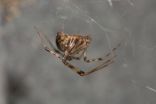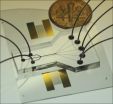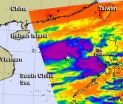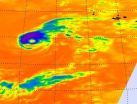(Press-News.org) STANFORD, Calif. — In the wilds of Africa, when it's time for a family of elephants gathered at a watering hole to leave, the matriarch of the group gives the "let's-go rumble" — as it's referred to in scientific literature — kicking off a coordinated and well-timed conversation, of sorts, between the leaders of the clan.
First, the head honcho moves away from the group, turns her back and gives a long, slightly modulated and — to human ears — soft rumble while steadily flapping her ears. This spurs a series of back and forth vocalizations, or rumbles, within the group before the entire family finally departs.
This curious behavior, measured and documented in a study published in the October issue of Bioacoustics, shows how this cognitively advanced species uses well-coordinated "conversations" to initiate cooperation within the group, said lead author Caitlin O'Connell-Rodwell, PhD, a field biologist and instructor in otolaryngology at the Stanford University School of Medicine. The use of "rumbles" to initiate departure helps explain the group's ability to work together to achieve more complicated tasks, such as rescue operations to save a calf from drowning.
"These vocalizations facilitate the bonds between the elephants to be able to work together," said O'Connell-Rodwell, who has been studying African elephants in the wilds for 20 years. "It's the measure of an organized society. It demonstrates how another social animal grouping organizes itself through vocalizations."
The study also indicates how this behavior uses rumbles in a structured way to transmit signals longer distances both through the air and through ground vibrations that could alert other elephant family groups not to approach the watering hole until they're gone, thus avoiding the mass chaos of too many large, noisy bodies at the same watering hole at the same time.
"I've seen 200 to 300 elephants at the same watering hole at one time before. There's a lot of vocalization and pushing and shoving and screaming and roaring. You can see why they'd want to avoid that," she said.
O'Connell-Rodwell has studied the elephants of the Mushara area of Etosha National Park in Namibia for 20 years, spending most of her summers hunkered down in a bunker or perched atop a tower cataloging more than 170 identified bulls and more than 15 family groups to understand the importance of long distance communication through both the air and ground. She is the author of the nonfiction science memoir, The Elephant's Secret Sense, which highlights her earlier work on elephants' ability to communicate by producing and listening to underground vibrations. She has also written one for children called The Elephant Scientist, which won both the Sibert and Horn Book nonfiction honors.
In this study, O'Connell-Rodwell focuses on sounds. She first noticed this apparent watering hole "departure" conversation years ago while observing the elephants in the wilds. The study occurred between July 1994 and July 1995. Researchers set up scientific observation sites at five watering holes in the Etosha National Park using instrumentation to provide acoustic measurements of the vocalizations and charting behaviors.
They counted the number of vocalizations beginning just as the elephant families arrived at the waterhole up until just after their departure. They found that usually only three of the 15-30 members of the group participated in the "conversations," which fit into the power structure of elephant hierarchies.
"They have a matriarch," O'Connell-Rodwell said. "Then there's this sort of secretary-of-state character, and then you have the general who brings up the rear." The families consist of the females and the calves. Males over the ages of 12 to 15 leave the herd and form their own groups.
She describes the sound of a rumble this way: "It's similar to listening to a truck in the distance. It's really striking, low frequency. You can almost imagine the cycling of the sound wave. It's kind of a throbbing in your chest." The deep sounds also travel by vibrations through the ground.
The study confirmed that elephants use vocalization to coordinate action, and that usually three callers are involved in this very coordinated turn-taking conversation.
"It's not just a chorus," O'Connell-Rodwell said. "As soon as one call ends, another call starts, then the next, then the next. It's connected like a string. Effectively they take a three-second call and turn it into a nine-second call."
The rate of coordinated calling significantly increased after the initiation of departure when compared to the pre-departure period. In an analysis of 14 of these back-and-forth episodes, 33 percent occurred pre-departure and 66.7 percent occurred during departure.
"These bouts increased in number as the elephants departed the waterholes," the study states, indicating that, they "appear to be true communicative events."
The study helps explain how these females can work together to achieve other tasks, said O'Connell-Rodwell, who went on to describe a scene she's witnessed several times as the leaders of a family worked together to save a calf from drowning.
"At our site, we occasionally get newborns falling into the trough. Sometimes the younger mothers get scared and traumatized, they swing their trunk around panicking. They don't know what to do. I've seen the matriarch and another high-ranking female kneel down and wrap a trunk around the baby and pull them out. The little calf is so distraught, the older siblings come and calm him down."
The study also suggests that the use of the longer, repeated calls are a method of communicating messages at a distance to other herds by increasing the length of the signal through both the air and ground. The repetition of this longer signal makes the calls more easily detectible at a distance.
"Most likely they're intending to send a message at a distance," O'Connell-Rodwell said. "It's a great recipe for getting your sound to transmit much further."
O'Connell-Rodwell is drawing analogies between humans and elephants in research conducted with hearing aids at Stanford. The hearing-impaired, she said, are much better at feeling vibrations and could benefit from research like this, which shows how longer, repeated vibratory signals are made and could be more easily detectible.
###
The study was funded by United States Agency for International Development/World Wildlife Fund-US, Namibia Nature Foundation, the University of California-Davis, Stanford's Bio-X Program, a Stanford faculty grant and the Seaver Institute.
Sunil Puria, PhD, consulting associate professor of mechanical engineering and of otolaryngology, is also an author of the study.
The Stanford University School of Medicine consistently ranks among the nation's top medical schools, integrating research, medical education, patient care and community service. For more news about the school, please visit http://mednews.stanford.edu. The medical school is part of Stanford Medicine, which includes Stanford Hospital & Clinics and Lucile Packard Children's Hospital. For information about all three, please visit http://stanfordmedicine.org/about/news.html.
For elephants, deciding to leave watering hole demands conversation, Stanford study shows
2012-10-03
ELSE PRESS RELEASES FROM THIS DATE:
University of Minnesota engineers invent new device that could increase Internet download speeds
2012-10-03
MINNEAPOLIS / ST. PAUL (10/02/2012) —A team of scientists and engineers at the University of Minnesota has invented a unique microscale optical device that could greatly increase the speed of downloading information online and reduce the cost of Internet transmission.
The device uses the force generated by light to flop a mechanical switch of light on and off at a very high speed. This development could lead to advances in computation and signal processing using light instead of electrical current with higher performance and lower power consumption.
The research results ...
1 glue, 2 functions
2012-10-03
Akron, Ohio, Oct. 2, 2012 — While the common house spider may be creepy, it also has been inspiring researchers to find new and better ways to develop adhesives for human applications such as wound healing and industrial-strength tape. Think about an adhesive suture strong enough to heal a fractured shoulder and that same adhesive designed with a light tackiness ideal for "ouch-free" bandages.
University of Akron polymer scientists and biologists have discovered that this house spider — in order to more efficiently capture different types of prey — performs an uncommon ...
Too little nitrogen may restrain plants' carbon storage capability, U of M paper shows
2012-10-03
MINNEAPOLIS / ST. PAUL (10/02/2012) —Plants' ability to absorb increased levels of carbon dioxide in the air may have been overestimated, a new University of Minnesota study shows.
The study, published this week in the journal Nature Climate Change, shows that even though plants absorb large amounts of carbon dioxide and actually can benefit from higher levels of it, they may not get enough of the nutrients they need from typical soils to absorb as much CO2 as scientists had previously estimated. Carbon dioxide absorption is an important factor in mitigating fossil-fuel ...
Acoustic cell-sorting chip may lead to cell phone-sized medical labs
2012-10-03
UNIVERSITY PARK, Pa. -- A technique that uses acoustic waves to sort cells on a chip may create miniature medical analytic devices that could make Star Trek's tricorder seem a bit bulky in comparison, according to a team of researchers.
The device uses two beams of acoustic -- or sound -- waves to act as acoustic tweezers and sort a continuous flow of cells on a dime-sized chip, said Tony Jun Huang, associate professor of engineering science and mechanics, Penn State. By changing the frequency of the acoustic waves, researchers can easily alter the paths of the cells.
Huang ...
Payoff lacking for casino comps
2012-10-03
A study of widely used complimentary offers at Atlantic City casinos finds that common giveaways such as free rooms and dining credits are less profitable – and lead to unhealthy competition among casinos – than alternative comps such as free travel and parking.
The research, co-authored by Seul Ki Lee, an assistant professor at Temple University's School of Tourism and Hospitality Management, analyzed monthly promotional allowance and expenditure data from 11 casinos in the Atlantic City market from 2008 to 2010. Atlantic City is the second largest gaming market in ...
Study reveals differences in overall health of Latino-American subgroups
2012-10-03
TALLAHASSEE, Fla. - Despite a shared Latino heritage, there are significant differences in the overall health and the use of health-care services among Cuban-Americans, Mexican-Americans and Puerto Rican-Americans — even between men and women in the same subgroup — according to two recently published studies by Florida State University researchers.
The authors, led by College of Social Work Professor and Associate Dean Amy L. Ai, evaluated the physical and behavioral health, as well as the health care service usage, of all three major Latino subgroups in the United States. ...
Cedars-Sinai study sheds light on bone marrow stem cell therapy for pancreatic recovery
2012-10-03
LOS ANGELES (Oct. 2, 2012) – Researchers at Cedars-Sinai's Maxine Dunitz Neurosurgical Institute have found that a blood vessel-building gene boosts the ability of human bone marrow stem cells to sustain pancreatic recovery in a laboratory mouse model of insulin-dependent diabetes.
The findings, published in a PLOS ONE article of the Public Library of Science, offer new insights on mechanisms involved in regeneration of insulin-producing cells and provide new evidence that a diabetic's own bone marrow one day may be a source of treatment.
Scientists began studying ...
NASA sees strong thunderstorms in Tropical Storm Gaemi
2012-10-03
Infrared NASA satellite imagery revealed that the strongest thunderstorms within Tropical Storm Gaemi in the western North Pacific Ocean were located around the storm's center and in a band of thunderstorms east of the center.
On Oct. 2, 2012 at 1500 UTC (11 a.m. EDT) Tropical Storm Gaemi had maximum sustained winds near 40 knots (46 mph/74 kph). It was located about 515 nautical miles (592 miles/954 km) east of Hue, Vietnam, near 15.3 North latitude and 116.7 East longitude. Gaemi is moving to the southeast at 9 knots (10 mph/16.6 kph).
Infrared imagery from the AIRS ...
NASA sees heaviest rainfall in Tropical Storm Maliski's eastern side
2012-10-03
Wind shear is pushing the heaviest rainfall within Tropical Storm Maliksi east of the storm's center, and NASA's TRMM satellite captured it on Oct. 2 as it passed overhead from space.
When NASA's Tropical Rainfall Measuring Mission (TRMM) satellite passed over Tropical Storm Maliksi on Oct. 2 at 1206 UTC (8:06 a.m. EDT), the precipitation radar instrument detected light rainfall occurring over most of the storm. The heaviest rainfall was moderate was falling east of the center at a rate between .78 to 1.57 inches/20 to 40 mm per hour. There was a small area of heavy rainfall ...
Infrared NASA imagery shows Nadine still has an eye, despite being a tropical storm
2012-10-03
Forecasters know that Tropical Storm Nadine is a fighter as it continues to stay alive in the eastern Atlantic Ocean. Even satellite imagery shows Nadine's fighting spirit, because although Nadine is now a tropical storm, infrared data clearly shows that Nadine maintained an eye early on Oct. 2.
At 11 a.m. EDT on Oct. 2, Nadine remains a tropical storm and appears to be weakening. Nadine's maximum sustained winds were near 65 mph (100 kph). The center of Tropical Storm Nadine was located near latitude 34.2 north and longitude 37.5 west. Nadine is moving toward the east-southeast ...





